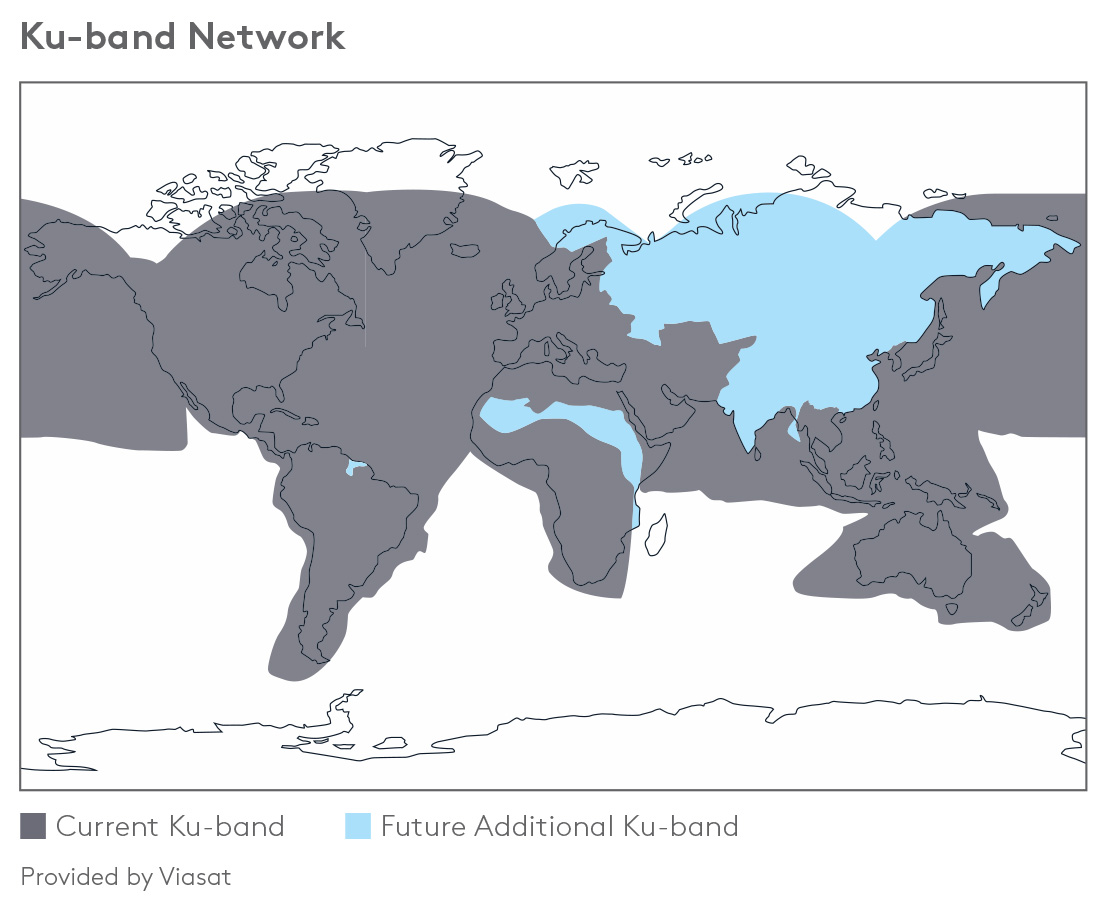Satellite bands have changed over the years and as technology improves, promise to change some more. You are generally better off studying the manuals you have to learn your system. If called upon to recommend something new, a little background information may be helpful.
— James Albright

Updated:
2019-06-01
The last time I had to research this was when outfitting our latest aircraft.

1
L-Band
The "L-Band" is what you probably use for your Inmarsat phones and datalink (ADS-C and CPDLC). If you also use it for Internet connectivity it probably has a branded name, such as "Swiftbroadband." As of 2018 we found this gets you about just over 100 KBPS but it could be worse depending on where in the world you are. The cost looks to be about $8 per MB but that adds up pretty quickly.

L-Band Network, Gulfstream Connectivity Brochure
- The L-band signal is at the lower end of the microwave spectrum can provide voice and low-speed data connections. Examples are Iridium and Inmarsat I-3 and I-4.
- Iridium has 66 low-earth satellites which create a global mesh which allows connectivity worldwide, including polar regions.
- Inmarsat I-4 satellites operate in the L-band and provide global coverage except in the polar regions and various satellite gap transition areas. Swift Broadband is available on the I-4 network and provides speeds up to 432 KBPS.
- Signals sent over the L-band have a lower through-put but are less susceptible to attenuation, making these systems reliable even in adverse weather conditions. This makes these systems a good choice for safety services.
In general, L-band networks are good for:
- Worldwide operations (just about)
- Voice calls
- Texting
- Up to 0.432 Mbps
Source: The Gulfstream Journal, September 28, 2018
2
Ku-Band

Ku-Band Network, Gulfstream Connectivity Brochure
- The Ku-band (12-18 GHz) and Ka-band (27-40 GHz) provide higher bandwidth on a higher frequency signal, but are more susceptible to signal attenuation.
- The Ku-band will allow users to surf the web and send and receive emails. Streaming is possible but not reliable. ViaSat 3.0 provides up to 6 MBPS.
- Ku-band covers much of the globe, but not China, Russia, India, parts of Africa, and the polar regions.
- Some T.V. systems use the Ku-band on antennas that are receive only.
In general, Ku-Band networks are good for:
- Worldwide operations (just about)
- Email with attachments
- Voice calls
- Texting
- VPN
- Internet browsing
- Up to 4 Mbps
Source: The Gulfstream Journal, September 28, 2018
3
Ka-band

Ka-Band Network, Gulfstream Connectivity Brochure
- Ka-band coverage is global.
- Ka-band systems (like JetConnex) offer the highest available throughput, making video streaming and teleconferencing possible.
In general, Ku-Band networks are good for:
- Worldwide operations (just about)
- Email with attachments
- Voice calls
- Texting
- VPN
- Internet browsing
- Video streaming
- Up to 15 Mbps
Source: The Gulfstream Journal, September 28, 2018
References
(Source material)
Connectivity Solutions, Gulfstream, gulfstream.com/connectivity
The Gulfstream Journal, September 28, 2018, www.mygulfstream.com
Please note: Gulfstream Aerospace Corporation has no affiliation or connection whatsoever with this website, and Gulfstream does not review, endorse, or approve any of the content included on the site. As a result, Gulfstream is not responsible or liable for your use of any materials or information obtained from this site.